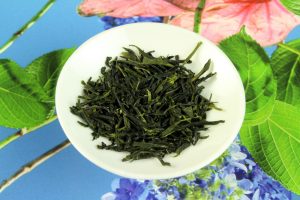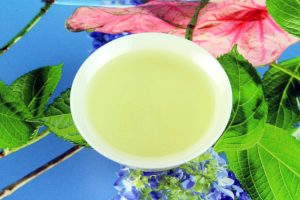I want to thank Ian Chun of Yunomi.life for sending me this sample for review.
One of the things about Japanese tea that I enjoy is tasting different cultivars.
This one, Terakawawase, is very uncommon. It’s the first time that I see it.
The tea leaves are from the spring harvest with a shading of two weeks. Technically, it is a kabusecha.
Marushige Shimizu Seicha (マルシゲ清水製茶) is located in Yokkaichi city, Mie prefecture. They have won a number of awards for their tea.
I can’t wait to find out what this tea tastes like!
A surprising green tea
Just with the aroma of the tea leaves I can tell that this isn’t going to taste like a common sencha.
It’s so different. Vegetal, but not like other Japanese green teas.
The familiar aroma that I’m used to find in sencha isn’t present.
But it does have the light, creamy fragrance of a green tea from the first harvest.
The appearance of the tea leaves looks good.
I prepared it as follows: One minute of infusion time, for 60 ml (2 oz) of water at 80 ºC (176ºF).
After the infusion, the wet leaves have an aroma that I don’t know how to describe accurately.
It’s like some kind of boiled vegetable with a deep smell. I can’t explain it very well, sorry.
I don’t feel sweetness, and definitely no seaweed nor marine notes that are often found in sencha.
The liquor has a light green color.
Just as with its aroma, the taste is unexpected.
What strikes me the most is that it lacks body and has a mild flavor. I’ll describe it as “watery”.
There is some sweetness and umami flavor, but it feels light overall.
It isn’t astringent nor bitter.
While the taste isn’t bad, I get the feeling that it lacks something. Nevertheless, the light sweetness is enjoyable.
I made another infusion with the same parameters.
The liquor has the same color as before, and the taste is pretty much the same.
A third infusion done in the same manner had a bit of astringency and bitterness.
And for the fourth and final infusion I just used boiling water for about ten seconds.
It still had the same flavor.
If someone had given me this tea while blindfolded, I would have never guessed that it was a sencha. That’s how different it feels.
Maybe I’m too used to the traditional sencha taste. I just don’t think that I would drink this tea very often.
But it’s such an unusual aroma and flavor, that it’s something that a Japanese green tea lover should try.
With this tea it’s easy to understand the impact that a cultivar can have on a type of tea.
Here’s the link to the product page on Yunomi.life.


